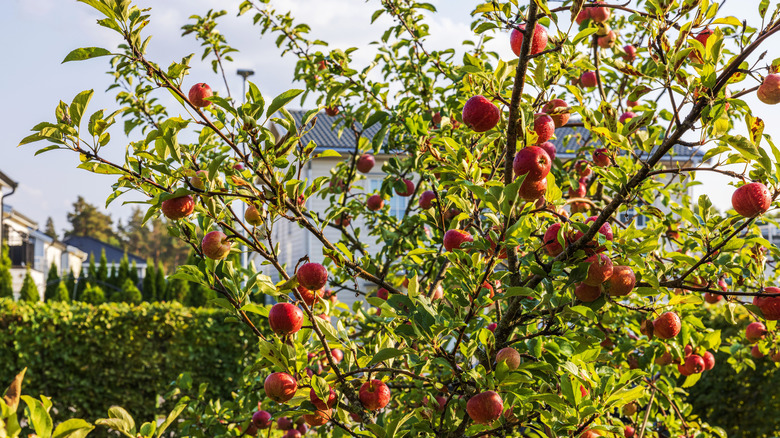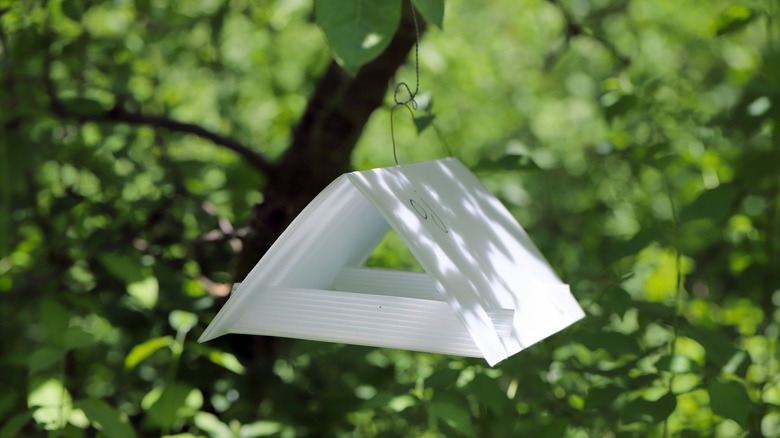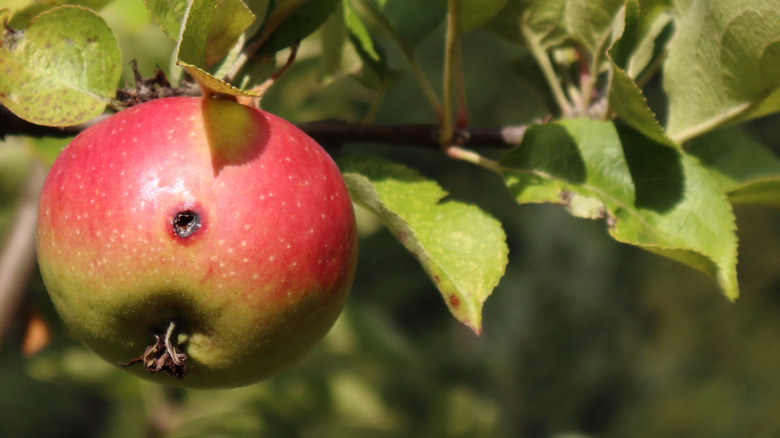How To Get Rid Of Codling Moths On Your Apple Trees
There are plenty of ways to help your apple trees thrive, such as pruning and choosing the right fertilizer. But what if your apples are turning brown and mushy before they're even ripe? Codling moths could be the culprit. They lay eggs on developing fruit, and once the larvae hatch, these little guys burrow into the apple's core — destroying your harvest from the inside out. But there's a low-toxic way to break the cycle. By pairing pheromone traps with natural treatments like kaolin clay and biological insecticides, you can put a stop to codling moths without resorting to harsh chemicals.
Pheromone traps are used first to monitor moth activity — they attract males, helping you detect when the moths are present so you can time your treatments. Applying kaolin clay as a barrier on your apples when moths are present can make the surface less appealing for egg-laying purposes. For active infestations, Bacillus thuringiensis kurstaki (Btk), a naturally occurring soil bacterium, kills only caterpillars and won't harm beneficial insects, pets, or humans. Time it right and this two-part method will help you get rid of codling moths without disrupting the rest of your garden. It's simple, affordable, and effective for both the prevention and treatment of this common apple tree pest.
How to apply this treatment method for best results
Start your treatment plan by hanging pheromone traps in your apple trees in early spring. As soon as you detect activity, begin applying the kaolin clay (you'll need to mix it with water to create a spray). This creates a protective film over the fruit and leaves, which discourages moths from laying eggs and larvae from feeding. Next, spray Btk as soon as you estimate that eggs have hatched. Apply it in the evening or on cloudy days, as sunlight can reduce its effectiveness. Since Btk only works if larvae ingest it shortly after hatching, you'll need to reapply it every seven to 10 days (and after it rains) to maintain coverage throughout the vulnerable window.
If you want a more low-key option, pheromone dispensers are worth a look. These small devices slowly release synthetic female scent, confusing male moths and preventing them from finding mates. It's a more humane alternative to killing pests directly, and a good long-term prevention tool for small home orchards. Dispenser systems are also more hands-off than sprays — no need to reapply — and some last for several weeks or even the whole season. To further boost your results, it's also worth pruning your apple tree and thinning the fruit to eliminate hiding places and improve airflow. While you're at it, make sure to pick up and destroy any fallen or infested apples — leaving them on the ground just helps the moths complete their life cycle. Combining these steps gives you a layered defense that's tough on pests but easy on your tree and the fruit it bears.
When to treat for codling moths (and how to spot the signs)
For these methods to work well, timing is everything — and that depends on your local climate. In most regions, adult codling moths start showing up in the spring, right around when your apple tree blossoms begin to form. That's your cue to hang pheromone dispensers (if you're using that approach) or pheromone traps and check them daily once you begin catching males. Once traps show activity (usually after full bloom), eggs are likely being laid within about a week, so pay attention.
Small holes in young apples, sometimes with frass (insect excrement), are another telltale sign of codling moths. These "stings" are a clear indicator of larvae burrowing in, and you should spray Btk spray as soon as you spot them to catch hatchlings while they're still exposed. In warmer areas, codling moths may produce multiple generations through the season, so you'll likely need to repeat the treatment cycle in midsummer to secure your next harvest. Keeping a consistent eye on your fruit and traps can mean the difference between homemade and store-bought apple pie.


